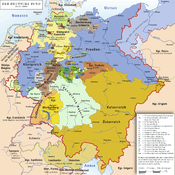Saxe-Gotha-Altenburg
| Duchy of Saxe-Gotha-Altenburg Herzogtum Sachsen-Gotha-Altenburg | ||||||
| State of the Holy Roman Empire, State of the Confederation of the Rhine, State of the German Confederation | ||||||
| ||||||
| ||||||
 Territories of Saxe-Gotha-Altenburg within the Ernestine duchies of Thuringia, before 1826 | ||||||
| Capital | Gotha | |||||
| Government | Principality | |||||
| Historical era | Early modern Europe | |||||
| - | Union of Saxe-Gotha and Saxe-Altenburg |
1672 | ||||
| - | Duchy established | 1680 | ||||
| - | Partitioned between Saxe-Coburg-Saalfeld and Saxe-Hildburghausen |
1826 | ||||
Saxe-Gotha-Altenburg (German: Sachsen-Gotha-Altenburg) was a duchy ruled by the Ernestine branch of the House of Wettin in today's Thuringia, Germany.
It was nominally created in 1672 when Frederick William III, the last duke of Saxe-Altenburg, died and Ernest I, Duke of Saxe-Gotha (who had married Frederick William's cousin, Elisabeth Sophie), inherited the major part of his possessions. It was common for the Ernestine duchies to merge and split; Ernest's combined duchy was divided again after his death in 1675, and the Duchy of Saxe-Gotha-Altenburg proper came into existence in 1680 with the completion of this division and the accession of his eldest son, Frederick to the subdivision centered around the towns of Gotha and Altenburg.
Frederick's residence remained at the Friedenstein Palace in Gotha. He decisively secured his family's possessions with the implementation of the primogeniture in 1685. Nevertheless when the last dukes Emil August and his brother Frederick IV had both died without male heirs, the house of Saxe-Gotha and Altenburg became extinct in 1825 and quarrels arose between the three remaining Ernestine lines about the succession.
As a result of an arbitration issued by King Frederick Augustus I of Saxony in 1826, the Ernestine duchies were rearranged and Saxe-Gotha-Altenburg was again split:
- Saxe-Gotha passed to the Duchy of Saxe-Coburg-Saalfeld, which had to cede Saxe-Saalfeld to Saxe-Meiningen. The territories constituted the newly created Duchy of Saxe-Coburg and Gotha.
- Saxe-Altenburg was given to the Duke of Saxe-Hildburghausen, who in turn passed his own domain to Saxe-Meiningen and again assumed the title of a Duke of Saxe-Altenburg.
After the abolition of German monarchies in the course of the German Revolution of 1918–1919, all former duchies became part of the newly created state of Thuringia in 1920.
Dukes of Saxe-Gotha-Altenburg
- Ernest I the Pious (1640–1675), inherited Saxe-Altenburg in 1675
- Frederick I (1675–1691), son of previous; first to bear the title Duke of Saxe-Gotha-Altenburg
- Frederick II (1691–1732), son
- Frederick III (1732–1772), son
- Ernest II (1772–1804), son
- Emil August (1804–1822), son
- Frederick IV (1822–1825), brother, line extinct.
Divided between the Dukes of Saxe-Coburg-Saalfeld and Saxe-Hildburghausen
See also
| |||||||
| |||||||||||||||||||||||
| |||||||||||||||||||||||||||||||||||||||||
| |||||||||||||||||||||||||||||||||||||||||||||





